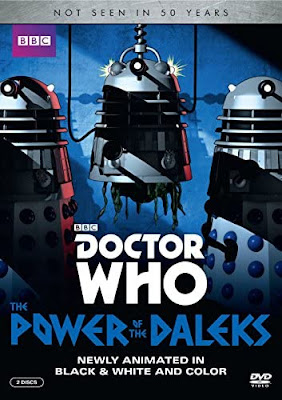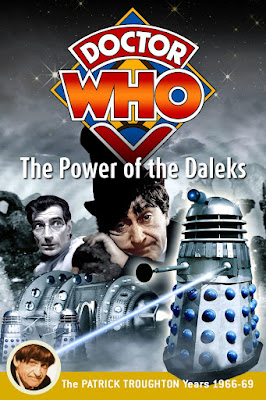Synopsis:
The trio of Daleks exultantly chant "We will get out power" - and Lesterson begins to harbour doubts about them...
He turns off the power supply and reminds them that they are servants and answer to him. He agrees to ration the amount of power they receive, whilst they provide the blueprints for the meteorite detection system which they promised.
Valmar instals a new communications system in the Governor's Office at the behest of Bragen, who has adopted a new uniform to reflect his elevation to Deputy Governor. Hensell has embarked on a tour of the outlying settlements.
The Doctor and Ben arrive and inform him of the disappearance of Polly and the threatening note they received. He dismisses their concerns but allows them to investigate by themselves. A Dalek arrives with a tray of drinks. The Doctor wonders aloud how much longer they will operate without metal floors to travel on.
They leave the office and see Janley pinning a note to a noticeboard, talking to a man named Kebble.
The Doctor explains to Ben about the Daleks' need for static electricity. Seeing them approach, Kebble quickly moves away from examining the board - prompting the Doctor to pay it closer attention.
They then see three Daleks moving down the corridor. They do not include the one they just saw in the Governor's Office, however.
There are now four of them.
They make for the laboratory to confront Lesterson. There, Janley has informed the scientist of Resno's death, blackmailing him into helping her and her fellow rebels. They wish to make use of the Daleks.
The Doctor arrives with Ben and demands to know if Lesterson has been manufacturing more Daleks.
On hearing that the creatures can achieve anything if given the right materials, Lesterson begins to worry about what he witnessed earlier. His sanity beginning to fracture, he has the Doctor thrown out before collapsing.
Valmar arrives, to help the Daleks lay a power cable for the new meteorite detection system. As far as Janley is concerned, the Daleks will help the rebels if they are helped in return.
The Doctor and Ben return to the noticeboard and examine it more closely. The Doctor spots a hidden message in the note Janley had added - details of a meeting that evening in one of the rocket rooms.
They arrive in advance of the gathering and witness Janley and Valmar exhibiting one of the Daleks to a group of colonists. The person in charge remains hidden in the shadows. Everyone sees the destructive power of the Dalek's weaponry, and it appears to obey Janley's orders. Valmar has fitted a control device to it.
A noise alerts the rebels to the uninvited witnesses, and Ben allows himself to be captured so that the Doctor can remain at large.
He discovers that the mysterious leader of the rebels is Bragen, and the Doctor knows that he is simply exploiting the movement for his own ends. He in turn knows the Doctor to be an imposter, and that no-one will believe his claims against the man who is now Deputy Governor. He intends to produce the real Examiner's body to prove his case - thus confirming the Doctor's suspicion that it was Bragen who had killed him in the first place.
Bragen has him placed under arrest and he is taken to the prison block where he is locked in a cell adjoining Quinn's.
As he investigates the nature of the cell locking mechanism, he tells Quinn of his discovery of the real Examiner and his death, and of Bragen's involvement with the rebels.
Lesterson has suffered a mild mental breakdown following his confrontation with the Doctor and the slow realisation that his warnings might have been justified. He witnesses two Daleks appearing to conspire in the darkness of his lab, and decides to investigate.
He sneaks onto their space capsule and discovers that more sections have been opened up. He moves deeper into the vessel and soon comes upon a large industrial space in which embryonic creatures are deposited inside new Dalek casings, which roll off a production line at a terrifying rate...
Data:Written by David Whitaker
Recorded: Saturday 12th November 1966 - Riverside Studio 1
First broadcast: 5:50pm, Saturday 26th November 1966
Ratings: 7.8 million / AI 47
Designer: Derek Dodd
Director: Christopher Barry
Additional cast: Steven Scott (Kebble), Peter Forbes-Robertson (Guard), John Scott Martin (Dalek)
Critique:
The rehearsal script for this episode was titled "The Destiny of Doctor Who" - a name which was also given to the story overall whilst David Whitaker worked on it.
The early scene between Valmar and Bragen was absent, reappearing later in the episode and reworked to include the Doctor and Ben.
At the noticeboard Janley was seen to drop an envelope, and the Doctor later spotted a number of these in her bag in Lesterson's laboratory.
The noticeboard code is broken in the finished episode by the Doctor reading the capital letters. In the draft, it was the final letters of each line which gave away the details of the meeting.
Whitaker's absence from Doctor Who is very obvious with his Daleks' reliance on metal floors and static electricity. These go back to their very first story only, and the Daleks had been seen to be perfectly mobile on any terrain ever since, even if they needed a little help from collection discs on their backs in their second story - Whitaker's final work on the show as Story Editor.
Terry Nation was unhappy with Whitaker's handling of his creations. We know from the documentary about Whitaker on The Collection - Season 2 box set that the two men had some serious fallings-out, including a physical punch-up.
In an interview with DWM, Nation later stated: "I didn't like David's episodes, where he had them being very sweet and very polite; that seemed totally alien to me..." "This is not to say that they were not good episodes; this is just my personal opinion. I didn't like them and I responded very badly to them".
However, Whitaker himself claimed, referring to the changes made after he went abroad: "It was a different kettle of fish when it was broadcast, and I wasn't desperately happy about the whole thing".
The model filming, including the Dalek production line, took place at Ealing between Monday 26th and Wednesday 28th September. A number of Herts Plastic Moulders' push-along Dalek toys were purchased from Woolworths and slightly adapted to make them closer to the full-size props.
The conveyer belt model was some 12 feet long.
Robert James (playing Lesterson) was present for reaction shots as he watched the Dalek activity from behind a window.
Derek Dodd and his team created the tentacled Dalek embryos from green latex, covered with shaving foam. One of the Daleks was fitted with a replacement utility arm which ended in a plastic sieve instead of the usual sink plunger.
One of the Dalek props was a lightweight one created from moulds of one of the cinema Daleks. It was this one, minus gun and utility arm, that was used for the scenes of the casing being lowered onto the base after the mutant had been placed inside.
As the Dalek numbers grew, so an additional operator was required in studio. This was John Scott Martin, who had first operated a Dalek in The Chase.
A small television monitor was added to the Governor's Office set, which allowed Peter Bathurst to be seen talking to Bragen from another part of the colony. The actor simply stood against a painted backdrop for this, and it was his only scene of the episode.
Anneke Wills was on holiday this week, and Ben was now abducted to allow Michael Craze to have the following week off.
(Despite being on holiday, Wills had filmed some scenes for The Highlanders the day before this studio session).
In editing, there was one small cut to the scene in which the Doctor and Ben go to see Bragen about Polly's disappearance. In this Bragen claimed that discipline in the colony was becoming lax, and fresh leadership was needed, to which the Doctor responded: "It depends on what kind of leadership, doesn't it?".
In 1995 a clip of the Dalek production line turned up in an Australian TV documentary series called Perspectives. The edition, originally screened on 29th May 1974, was titled C for Computer.
In an interview with DWM, Anneke Wills vividly recalled the scene: "I still have nightmares about The Power of the Daleks, because there was this one scene where you were confronted by an endless row of Daleks, just coming at you! Something about the fact that there was a, sort of, inevitability... This kind of robotic movement. And there were no eyes, and no face - even the Cybermen had mouths and eyes, but the Daleks had nothing but eyes and plungers. They still give me nightmares...".
Some other clips from this episode turned up in September 2005 when they featured in nostalgia series Sunday Times Past. They had been sourced from an episode of Tomorrow's World, broadcast on 28th December 1966.
Trivia:- The ratings and appreciation figure rise slightly, with the episode now in the Top 50 programmes for the week - though only just (50th place).
- At the BBC Programme Review meeting on 30th November, Controller of TV Programmes Huw Weldon - a big Dalek fan - had it confirmed that photographic blow-ups were employed in the background to bulk up their numbers. Christopher Barry had first used this technique in their very first story. Often derided these days, though only by people who are ignorant of the fact that Doctor Who used to be watched on small 405-line screen televisions (average screen size in the mid-1960's was 17").
- Unless the Daleks have knocked through to some spacious but unused section of the colony, their space capsule clearly shares its bigger-on-the-inside dimensions with the TARDIS and their own time machines, as seen in The Chase and the second half of The Daleks' Master Plan. The odd thing is that no-one remarks on this - least of all scientist Lesterson.
- The Doctor claims to have solved the rebels' code by spotting that they employ an anagram. This is a mistake. What the Doctor should have said is that they use an acrostic.
- Peter Forbes-Robertson, who features as a guard in this episode, would return to the programme in the Pertwee era, playing one of the Time Lords in the opening scene of Colony in Space, and later the Chief Sea Devil.
- The Radio Times covering 26th November to 2nd December published the following letters. A thumbs up for Troughton, a thumbs down, and a thank-you to William Hartnell.

- Mike Tucker constructed a model of the Dalek production line for an extra on the DVD / Blu-ray release. It was on display at Gunnersbury Park Museum in 2023/24:













































